Effect of liming on soil properties, yield and nutrient uptake by wheat
B.S. Sultana1 * , M.M.H. Mian2 , M.R. Islam2 , M.M. Rahman3 , Bikash C. Sarker4 and M.S. Zoha4
1
S.O. Soil Resource Development Institute,
Nasipur,
Bangladesh
2
Department of Soil Science,
Bangladesh Agricultural University,
Mymensingh,
Bangladesh
3
Department of Soil Science,
Hajee Mohammad,
Danesh Science and Technology University,
Dinajpur,
5200
Bangladesh
4
Departemnt of Agricultural Chemistry and Biochemistry,
Hajee Mohammad,
Danesh Science and Technology University,
Dinajpur,
5200
Bangladesh
DOI: http://dx.doi.org/10.12944/CWE.4.1.06
A study was conducted to evaluate the effects of liming on chemical properties of wheat field soils and yield of wheat in Ranisankail soil series of Bangladesh. There were eight treatments of liming material applied from dolomite (CaCO3.MgCO3). Yield and yield components of wheat were recorded at harvest and the grain and straw were analyzed for P, S, Ca and Mg contents. The post harvest soils were analyzed for pH, available P, Ca and Mg. The application of different rates of lime to soil progressively increased soil pH and increased availability of P, Ca and Mg in soils. The pH of the post harvest soils was positively correlated with available Ca and Mg status of soils. The grain yields of wheat were positively correlated with soil pH, available P, Ca and Mg contents of post harvest soils. Tiller number plant-1, spikelets spike-1, grains spike-1, grain and straw yields were significantly affected by liming. The treatment T5 (2.0 t lime ha-1) produced grain yield of 4659 kg ha-1 which was statistically identical to those found in T6, T7 and T8 treatments but higher to those in T1, T2, T3 & T4 treatments. Liming markedly increased S and Mg concentrations of wheat grain but the concentrations of P and Ca remained unaffected. Total uptake of P, S, Ca and Mg were increased due to application of lime which was mainly associated with increased wheat yields. The findings showed that liming is beneficial for wheat cultivation in the Ranishankail soil series of Dinajpur. The application of 2.0 t lime ha-1 appears to be optimum for desired soil pH for wheat (>pH 6.0), increased availability of nutrients and ultimately increased wheat yield.
Copy the following to cite this article:
Sultana B.S, Mian M.M.H, Islam M.R, Rahman M.M, Sarker B.C, Zoha M.S. Effect of liming on soil properties, yield and nutrient uptake by wheat. Curr World Environ 2009;4(1) :39-47 DOI:http://dx.doi.org/10.12944/CWE.4.1.06
Copy the following to cite this URL:
Sultana B.S, Mian M.M.H, Islam M.R, Rahman M.M, Sarker B.C, Zoha M.S. Effect of liming on soil properties, yield and nutrient uptake by wheat. Curr World Environ 2009;4(1):39-47. Available from: http://www.cwejournal.org/?p=885
Download article (pdf)
Citation Manager
Publish History
Select type of program for download
| Endnote EndNote format (Mac & Win) | |
| Reference Manager Ris format (Win only) | |
| Procite Ris format (Win only) | |
| Medlars Format | |
| RefWorks Format RefWorks format (Mac & Win) | |
| BibTex Format BibTex format (Mac & Win) |
Article Publishing History
| Received: | 2009-01-02 |
|---|---|
| Accepted: | 2009-03-03 |
Introduction
Wheat grain is one of the most important cereal crops in Bangladesh. The wheat yield in this country is low. There are several reasons that can explain the yield variation, which cover both biotic and abiotic factors. Among the biotic factors, unavailability of high yielding varieties,1 incidence of diseases and pests² and abiotic factors such as high temperature,3 moisture stress4 and nutrient deficiency5,6,7 are responsible for lower productivity of wheat in the tropics and sub-tropics.
The soils of northwest part of Bangladesh are light textured, low in organic matter and strongly acidic to moderately acidic in nature, pH ranges from 4.5 to 5.5.8 The status of available P, Ca and Mg of these soils are low. The sandy soil has low cation exchange capacity. These soils have high content of aluminum, iron, and manganese9 and deficiencies of nitrogen, calcium, magnesium, potassium, phosphorus and boron are common. Aluminum toxicity is responsible for poor yields in acid soils.10
Liming on acid soil increases the pH level, decrease Fe, Al and Mn toxicity, increase the availability of N, P, Ca and Mg and microbial activities. In acid soils application of lime and farmyard manure significantly increased water- soluble nitrogen and fixed ammonium. Therefore, a study was under taken in a highly acidic soil of Dinajpur, to see the changes in chemical properties of soil due to liming in wheat field and to evaluate the effect of lime on yield, yield contributing characters and nutrient composition of wheat.
Material and Methods
The experiment was conducted in the farm of Hajee Mohammad Danesh Science and Technology University, Dinajpur from November 2006 to March 2007. The experimental field is located at 25038½ N latitude and 88o 41½ E longitude at a height of 34.5 m above the mean sea level. It belongs to the Agro Ecological Zone 1 (Old Himalayan Piedmont plain). The soil was sandy loam having pH 4.85, organic matter 0.96%, total N 0.06%, available P 43.36 µg g-1, K 0.18 meq 100 gsoil-1, available Ca 1.21 meq 100 gsoil-1, Mg 0.39 meq 100 gsoil-1and S 2.72 µg g-1. The test crop was wheat Triticum aestivum cv Bijoy for the study. Certified seeds were collected from the Wheat Research Centre, Nashipur, Dinajpur. There were eight different doses of lime application in wheat as follows T1 (Control); T2 , 0.5 t ha-1 lime; T3 , 1.0 t ha-1 lime; T4 , 1.5 t ha-1 lime; T5 , 2.0 t ha-1 lime; T6 , 2.5 t ha-1 lime; T7 , 3.0 t ha-1 lime and T8 , 3.5 t ha-1 lime. The liming material had 20% Ca and 10% Mg. The liming material was applied to the soil on 1 November 2006 and mixed well with soil by repeated ploughing by power tiller and country plough. Final land was prepared on mid November, 2006.
The exper iment was laid out in a Randomized Complete Block Design with three replications. There were altogether 24 (8´3) unit plots (5´4 m). Inter-block and Inter-plot spacing were 1m and 0.7m, respectively. Fertilization was as N @ 130 kg ha-1 from urea, P @ 5.5 kg ha-1 from TSP, K @ 54 kg ha-1 from MoP, S @ 33 kg ha-1 from gypsum, Zn @ 3.6 kg ha-1 from zinc sulphate (monohydrate) and B @ 0.6 kg ha-1 from boric acid.
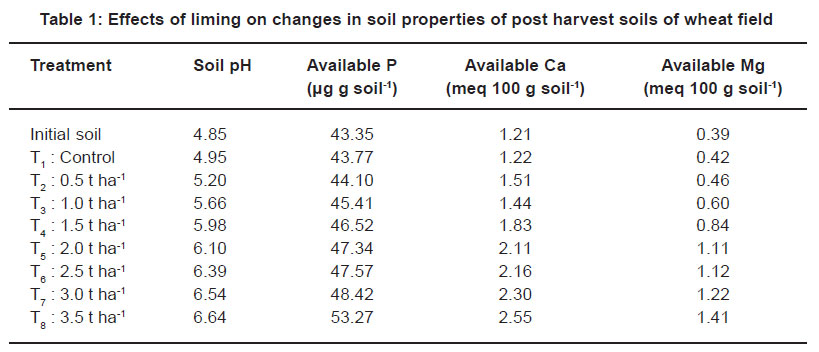 |
Table 1: Effects of liming on changes in soil properties of post harvest soils of wheat field Click here to view table |
Three irrigations were applied, the first irrigation after 12 days of sowing, second irrigation after 22 days of sowing at crown root initiation stage and the third after 58 days of sowing at heading stage. Weeding and pest control program were done when necessary.
The crop was harvested at maturity after about four months of sowing (March 23, 2007). Ten plants from each plot were sampled randomly recording for yield parameters. Then plot- wise weights of grain and straw were recorded.
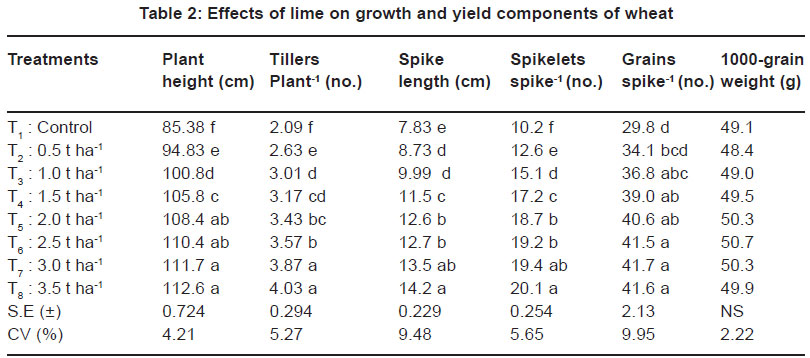 |
Table 2: Effects of lime on growth and yield components of wheat Click here to view table |
Analysis of Soil and Plant Samples
Soil samples were collected randomly from 10 different spots of the field from a depth of 0-15 cm. After harvest of wheat, the soil samples from each plot were collected at a depth of 0-15 cm. The initial soil samples were analyzed as per standard methods for soil texture, pH, organic matter, total N and available P, K, S, Ca, Mg, contents[11]. The post harvest soils were analyzed for soil pH, available P, Ca and Mg. Plant extract for grain and straw were prepared by wet oxidation method using diacid (HNO3 : HClO4 = 2:1) mixture method. Phosphorous content was estimated by developing blue colour absorbance with Ammonium molybdate- ascorbic acid solution and measur ing the colour by spectrophotometer at 890 nm wavelength12. Ca and Mg from the plant extract were determined by AAS. Sulphur from the extract was determined by turbidimetrically using barium sulphate by spectrophotometer. The data were analyzed statistically13 by F-test to examine whether the treatment effects were significant or not. The mean comparisons of the treatments were evaluated by DMRT (Ducan’s Multiple Range Test) if the treatments were significant. The analysis of variance (ANOVA) for different parameters was done by a computer package programme “MSTATC”.
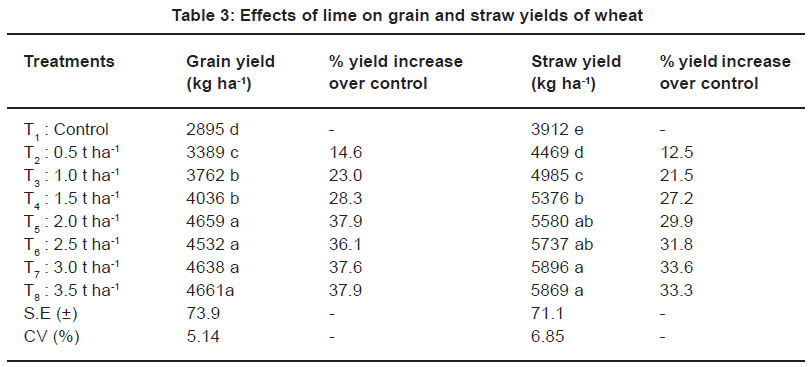 |
Table 3: Effects of lime on grain and straw yields of wheat Click here to view table |
Results and Discussion
Chemical Properties of Post Harvest Soils
The changes in pH, P, Ca and Mg content in soil markedly varied after the harvest of wheat. The pH values, P, Ca and Mg availability of the post harvest soils in different treatments of wheat increased steadily with increasing rates of lime application (Table 1 and Fig. 1a). The pH of the initial soil was 4.85 which increased to 5.20, 5.66, 5.98, 6.10, 6.39, 6.54 and 6.64 in T1, T2, T3, T4, T5, T6, T7 and T8 respectively. The increased in soil pH was due to available of Ca and Mg in soils (Figs. 1a,b and c). The initial value of available phosphorus in the soil was 43.35 µg g-1 soil and the post harvest soils had the values 43.77, 44.10, 45.41, 46.52, 47.34, 47.57, 48.42 and 53.27 ìg g-1 soils in T1, T2 , T3, T4, T5, T6, T7 and T8 respectively. The status of available P of soils was positively correlated with the rates of lime application (Fig. 1d). Lime application increased the soil pH which helped the release of fixed P from the oxides and hydroxides of Fe and Al thus increased the P availability in soils.The available Ca of the initial soil was 1.21 me 100 gsoil-1 which increased to 1.22, 1.51, 1.44, 1.83, 2.11, 2.16, 2.30 and 2.55 meq 100 g soil-1 in T1, T2,T3, T4, T5, T6, T7 and T8 respectively. The liming material used as dolomite (CaCO3 .MgCO3 ), which on dissolution released a large amount of Ca & Mg and thus the available of Ca increased in post harvest soils. The available Mg of the initial soil was 0.39 meq 100 g soil-1 which increased to 0.42, 0.46, 0.60, 0.84, 1.11, 1.12, 1.22 and 1.41 meq 100 gsoil-1 in T1, T2 , T3, T4, T5, T6, T7 and T8 treatments respectively.
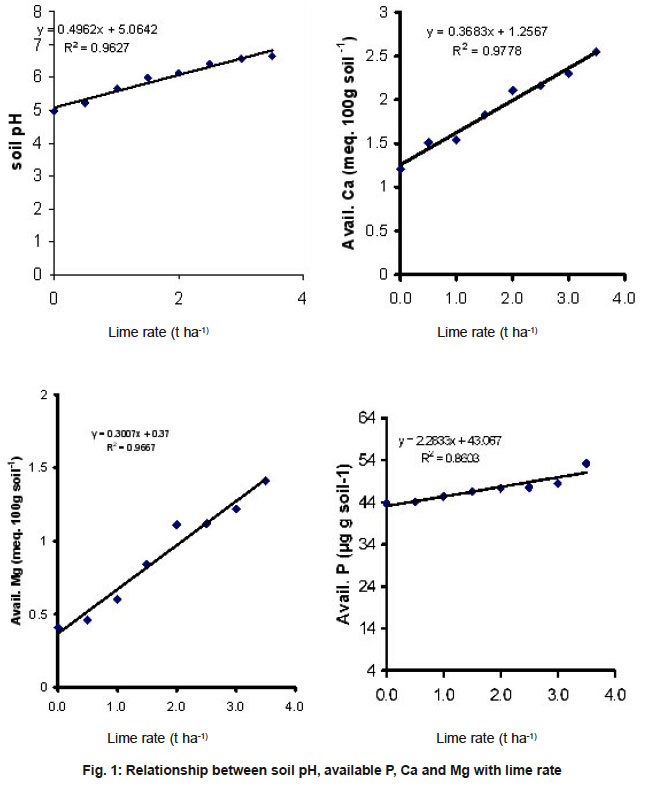 |
Figure 1: Relationship between soil pH, available P, Ca and Mg with lime rate Click here to view figure |
Yield Components
The application of different rates of lime significantly increased the plant height, the number of tillers plant-1, spike length, the number of spikelets spike-1 and the number of grains (Table 2). Plant height of wheat progressively increased with increase in lime rates. The plant height ranged from 85.38 cm in T1 (control) treatment to 112.60 in T8 treatment. The tallest plant recorded in T8 was significantly comparable to those obtained in T5, T6 and T7 treatments. All the treatments of T1, T2, T3 and T4 differed statistically from each other in plant height. The number of tillers plant-1 by different treatments varied from 2.09 to 4.03. The highest number of tillers was obtained in the treatment T8, which was statistically similar with T7 and superior to all other treatments. The treatments T6 and T5 recorded the identical number of tillers plant-1. Again the treatments T4 and T5 were statistically identical in producing tillers plant-1. The treatments T4 and T3 were also statistically identical and superior to T2 and T1 treatments.
Spike length of wheat ranged from 7.83 to 14.20 cm, tallest spike was found in T8 treatment which was statistically similar to T7. The treatment T7 recorded the spike length of 13.5 cm which was comparable to those found in T6 and T5 treatments. The treatment T4 was statistically superior to T2 and T3 treatments in terms of spike length. The treatments T2 and T3 were identical in recording spike length. spikelets spike-1 ranged from 10.2 in T1 treatment to 20.1 in T8 treatment. The number of spikelets spike-1 was found maximum in T8 treatment which was statistically similar to T7. The number of spikelets spike-1 in T7 was statistically identical to those found in T5 and T6 treatments. The treatment T4 was superior to T3 treatment in recording the number of spikelets spike-1. The number of spikelets spike-1 in T3 was statistically superior to the spikelets spike-1 recorded in T2 treatment. The number of grains spike-1 of wheat ranged from 29.8 to 41.6. The highest number of grains was found in T7 treatment which is statistically similar to all the treatments except T1 and T2. The treatments T3 and T2 recorded identical number of grain spike-1. Again the treatment T2 recorded higher number of grains spike-1 over T1 treatment but they were statistically alike. Liming had non significant effect on the 1000-grain weight of wheat (Table 2). The 1000- grain weight of wheat varied from 48.4 g to 50.7 g. The 1000 grain weight for T6 was highest (50.7 g) and the lowest was in T2 (48.4 g). The 1000 grain weight for T5 was in 2nd highest (50.3 g).
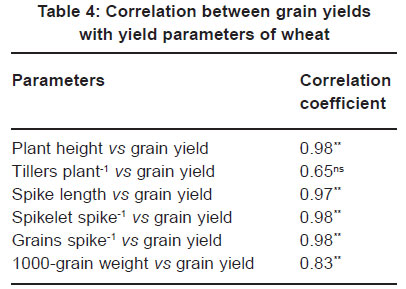 |
Table 4: Correlation between grain yields with yield parameters of wheat Click here to view table |
Grain yield of wheat (var. Bijoy) was significantly responded due to application of different rates of lime (Table 3). The highest grain yield was found in T8 (4661 kg ha-1) while the lowest in T1 treatment. The treatments T5, T6, T7 and T8 produced statistically identical grain yields of wheat. The treatments T3 and T4 recorded identical grain yields of wheat. The application 0.5 t lime ha-1 (T2) significantly increased the grain yield of wheat compared to control treatment. Application of lime increased grain yield of wheat to a considerable extent but application of lime at the rate of 2.0 t ha-1 was enough for desired yield of wheat. The application of 0.5, 1.0, 1.5, 2.0, 2.5, 3.0 and 3.5 t lime ha-1 recorded 14.6, 23.0, 28.3, 37.9, 36.1, 37.6 and 37.9% yield increase compared to lime control treatment (Table 3) The grain yield of wheat was positively correlated with different plant characters like plant height (r=098**), spike length (r=0.97**), spike let spike-1 (r=0.98**), grains spike-1 (r=0.98**) and 1000-grain weight (r=0.83*) (Table 4). The grain yield of wheat was affected due to changes in soil properties due to liming. The grain yield was quadratically related with soil pH (R2=0.9354), available P (R2=0.937**), available Ca (R2=0.943**) and available Mg (R2=0.9572**) (Fig. 2). It appears that liming increased soil pH and availability of nutrients which increased the yield components of wheat finally higher yields of wheat. The application of lime 0.5, 1.0, 1.5, 2.0, 2.5, 3.0 and 3.5 t ha-1 recorded 14.6, 23.0, 28.3, 37.9, 36.1, 37.6 and 37.9% yield increase compared to lime control treatment. Surface liming caused increases up to 140% in the grain yield of wheat.14 Besides mineral and organic fertilization, liming also rendered significantly higher yields compared to the control and relatively higher yields than treatments involving mineral fertilizers.15 Liming considerably influenced the yields of the field crops and single application of high rates was the better choice compared with repeated use of low rates16. The highest straw yield of 5896 kg ha-1 was observed in T7 treatment and was statistically identical to those found in T5, T6 and T8 treatments (Table 3). The treatments T4, T5 and T6 were also statistically identical. The treatment T4 was different from T2 and T3 treatments. The treatment T2 showed statistically higher straw yield compared to that found in T1 treatment. The application of 0.5, 1.0, 1.5, 2.0, 2.5, 3.0 and 3.5 t lime ha-1 recorded 12.5, 21.5, 27.2, 29.9, 31.8, 33.6 and 33.3% yield increase compared to lime control treatment.
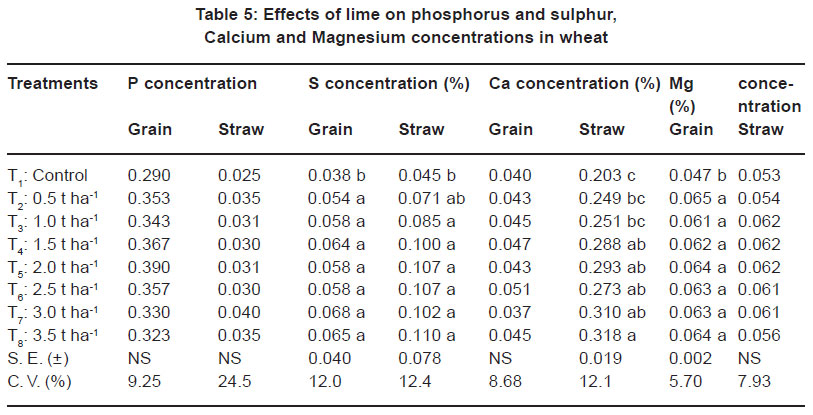 |
Table 5: Effects of lime on phosphorus and sulphur, Calcium and Magnesium concentrations in wheat Click here to view table |
Nutrient Concentration in Wheat
The application of lime to wheat increased the P concentration in grain and straw but such increase was not statistically significant (Table 5). The grain P concentration ranged from 0.29 % in T1 treatment to 0.39 % in T5. In straw, P concentration ranged from 0.025 % in T1 to 0.040 % in T7. The S concentrations of grain and straw were affected significantly due to application of different rates of lime (Table 5). All the liming treatments showed statistically identical grain S concentration but significantly higher than the lime control treatment (T1). In case of wheat straw, the S concentrations in all of the liming treatments were statistically identical. The treatment T2 showed statistically identical straw S concentration with lime control treatment (T1).
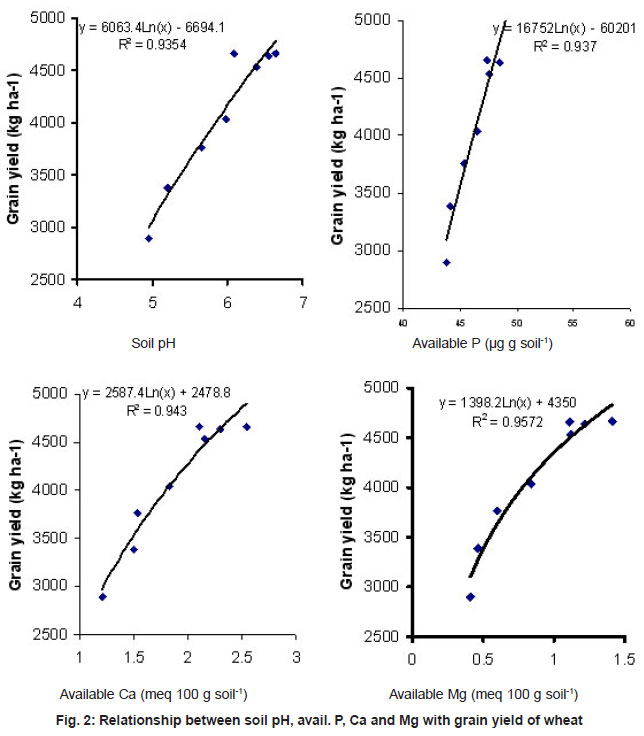 |
Figure 2: Relationship between soil pH, avail. P, Ca and Mg with grain yield of wheat Click here to view figure |
The concentration of Ca in wheat grain remained unaffected due to lime application while in straw it was significantly increased (Table 5). The concentration of Ca in straw was much higher compared to those of straw. The concentration of Ca in wheat grain ranged from 0.037% in T7 to 0.051% in T6 treatment. In wheat straw, the highest Ca concentration of 0.318% was noted in T8 treatment which was statistically identical to those found in T4, T5, T6 and T7 treatments. Again the treatments T2, T3, T4, T5, T6 and T7 were statistically identical in recording the Ca concentration in wheat straw. The concentration of Mg in wheat grain was significantly increased while the concentration in straw remained unaffected due to the application of different rates of lime (Table 5). In grain, the application of all rates of lime showed identical concentration of Mg but superior to control treatment. In wheat straw, the concentration of Mg increased due to liming but such increase was not statistically significant. The Mg concentration in wheat straw ranged from 0.053% in T1 treatment to 0.062% in T5 treatment.
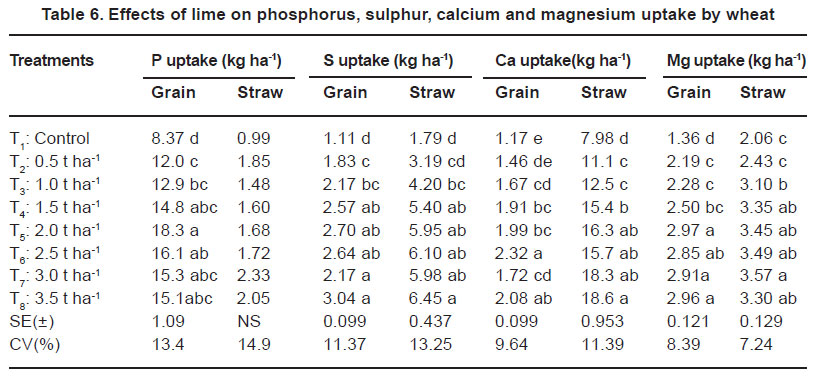 |
Table 6. Effects of lime on phosphorus, sulphur, calcium and magnesium uptake by wheat Click here to view table |
Nutrient Uptake
Total P uptake by wheat was significantly affected by different rates of lime application (Table 6). The highest total P uptake was found in T5 treatment which was statistically identical to those found in T4, T6, T7 and T8 treatments. Again the treatments T7, T8, T1, T2, T3, and T4 were statistically identical in terms of total P uptake. Total S uptake by wheat was significantly affected by different rates of lime application (Table 6). The highest total S uptake was found in T8 treatment which was statistically identical to those found in T4, T5, T6 and T7 treatments. Again the treatments T3, T4 and T5 were statistically identical in terms of total S uptake. The treatment T2 recorded higher total S uptake compared to that of T1 treatment but such increase was not statistically significant.
Total Ca uptake by wheat was significantly affected by different rates of lime application (Table 6). The highest total Ca uptake was found in T8 treatment which was statistically identical to those found in T5, T6 and T7 treatments. Again the treatments T4, T5, T6, and T7 were statistically identical in terms of total Ca uptake. The treatments T2 and T3 were statistically identical and superior to control treatment (T1).
The highest total Mg uptake by wheat ranged from 3.42 kg ha-1 in T1 treatment to 6.48 kg ha-1 in T7 treatment which was statistically identical to those found in T5, T6 and T8 treatments. The treatments T4, T6 and T8 were statistically identical in terms of total Mg uptake by wheat. The treatment T2 recorded significantly higher amount of total Mg uptake by wheat compared to T1 treatment.
It appears that lime application in Old Himalayan Piedmont Soil (AEZ 1) increased soil pH, availability of nutrient which in term of increased yield of components and yield of wheat. It is inferred that the amount of lime 2.0 t ha-1 may be optimum for wheat cultivation in the AEZ 1.
References
- Rerkasem, B., Netsangtip, R., Lordkaew, S. and Cheng, C., Grain set failure in boron deficient wheat. In Proc: Twelfth International Plant Nutrition Collquium, N. J. Barrow (ed.),(1993) 401-404.
- Hossain, I., Yahia, G. and Jahiruddin, M., Effects of copper, boron and molybdenum on leaf spot disease and grain set of wheat. Bangladesh J. Train. Dev. (1995) 8: 77-81.
- Orakwue, F. C., Wheat germplasm development for heat and drought tolerance for Nigeria. Proc: Wheat for more tropical environment. UNDP/CIMMYT (1984).
- Bingham, Varietal response in wheat to water supply in the field and male sterility caused by a period of drought in a glasshouse experiment. Ann. Appl. Biol.(1966) 57: 599-608.
- Rerkasem, B., Lodkaew, S. and Jamjod, S., Assessment of grain set failure and diagnosis for boron deficiency in wheat. In Proc: Wheat for the Nontraditional Warm Areas. D.A. Saunders (Ed.), pp. 500-504, Mexico D.F.: CIMMYT (1991).
- Jahiruddin, M. Hoque, M. S., Haque, A. K. M. M. and Roy, P. K., Influence of boron, copper and molybdenum on grain formation on wheat. Crop Res.(1992) 5: 35-42.
- Islam M. R., Islam, M. S., Jahiruddin, M. and Hoque, M. S., Effects of sulphur, zinc and boron on yield, yield components and nutrient uptake of wheat. Pakistan J. Sci. Ind. Res.(1999) 42(8): 137-140.
- BARC (Bangladesh Agricultural Research Council), Fertilizer Recommendation Guide-2005. Soil Pub. No. 45. Farmgate, Dhaka (2005).
- Breemen, N. Van, Genesis and Solution Chemistry of Acid Sulphate Soils in Thailand. Wagneningen, Centre for Agricultural Publishing and Documentation (1973).
- Lierop, W. Va., T. S. Tran, G. Banville and S. Morissette., Effect of liming on potato yields as related to soil pH, aluminium, manganese and calcium. Agron. J. (1984) 74: 1050-1055.
- Page, A. L., Miller, R. H. and Keeny, D. R., Methods of Soil Analysis. Part-I and Part-II. 2nd Ed. Ani. Soc. Agron. Inc. Madi., Wis., USA (1982).
- Petersen, L., Soil Analytical Methods. Soil, Water, Plant Material, Fertilizer. Soil Resource Management and Analytical Services. Soil Resource Development Institute, Danida Kampsax, Dhaka (2002).
- Gomez, K.A. and Gomez, A.A., Statistical Procedures for Agricultural Research. 2nd Edt. A Wiley Inter Sci. Publi. John Wiley & Sons., New York (1984).
- Caires, E.F., J.C.L. Correa, S. Churka, G. Barth, F.J. Garbuio., Surface application of lime ameliorates subsoil acidity and improves root growth and yield of wheat in an acid soil under no-till system. Scientia-Agricola. (2006) 63(5): 502-509.
- Kisic, I., F. Basic, M. Mesic, A. Butorac., Efficiency of mineral and organic fertilization and liming in growth maize and winter wheat. Agriculturae Conspectus Scientificus Poljoprivredna Znanstvena Smotra. (2002) 67(1): 29-37.
- Jovanovic, Z., I. Djalovic, I. Komljenovic, V. Kovacevic, M. Cvijovic., Influence of liming on vertisol properties and yields of the field crops. Cereal Research communications.(2006) 34(1(II): 517-520.






